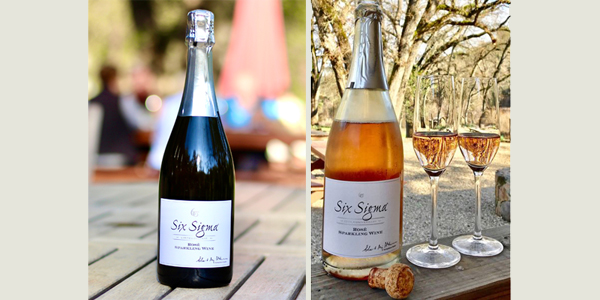Bubbles!
Release date for the 2020 vintage of Six Sigma Sparkling Rosé is 11/26/2022!
Flashback to our first bubbles – The 10th Anniversary Sparkling Rosé 2015.

When our first sparkling wine was ready to launch in May 2017, our Rosé expert Marianne (of Six Sigma’s “Marianne’s Rosé”), sat down to interview proprietor (and chemist) Else about how this very special sparkling Rosé was produced.
Marianne: What’s the difference between Champagne and this Sparkling Rosé?
Else: There’s not that much difference – except that a classic Champagne is produced in the region of Champagne, France. The method used to produce our Sparkling Rosé is very similar to what vintners do in the Champagne region. One detail, though – we combined our Pinot Noir grapes with Sauvignon Blanc instead of traditionally used Chardonnay.
M: Sparkling wine is so festive – why don’t you make it every year?
E: It may be twice the fun, but it is also twice the work, with two different fermentation processes. When the regular fermentation has produced most of the alcohol, the wine needs a second fermentation to produce the bubbles. This last fermentation takes special equipment – that is why we sent our base wine to Gerald Ployez (an esteemed French Champagne maker who happens to be our Lake County neighbor) for the final touch. And, we were waiting for a special occasion (our 10th anniversary!) to produce such a fun varietal.
M: So, what happened to the wine at Ployez Winery?
E: Gerald bottled our base wine with a small addition of yeast and sugar. Then he capped the bottles with crown caps to withstand the extra pressure that would develop in the bottles when the yeast started fermenting the added sugar into carbon dioxide (“bubbles”) and alcohol. When the fermentation was complete, the yeast cells died and settled in the lower part of the bottles that at this point were resting horizontally.
M: So, once the wine had the bubbles, it still needed to get rid of the settled yeast, right?
E: Yes! Gerald tilted the bottles and rotated them over a period of time, until all of the yeast cells had gathered in the bottlenecks. Then he immersed the bottlenecks in freezing liquid, producing a plug of frozen wine that encapsulated all of the yeast. When Gerald moved the crown caps, the sparkling wine’s internal bottle pressure made the yeast-filled plug shoot out, leaving the clear wine in the bottle. Now he just needed to balance the taste of the wine by adding to each bottle a small amount of sugar dissolved in wine. The corks were put in and secured with wire to withstand the pressure of the bubbles.
M: Did this final addition of sugar make the wine sweet?
E: No, not at all. Sandy, our winemaker, did some trials with the team before the sugar additions were made. We decided to add 7 g/liter = 0.7%. That was just enough to balance the acidity of the grapes we’d picked before they reached full maturity. Our wine is in the Brut group of sweetness that allows a sugar content up to 12 g/liter. For comparison, Extra Dry has 12-17 g/liter, and Doux = sweet, has at least 50 g/liter.
Both: We’re so excited for you to try this wine. Cheers!
POST SCRIPT. It would take another five years before we got around to produce the second vintage of bubbles, the 2020 Sparkling Rosé Wine! For this vintage, Gerald Ployez and Six Sigma winemaker Kathryn Finn worked together to put the final touches on the wine and find just the right balance between sweetness and acidity.


